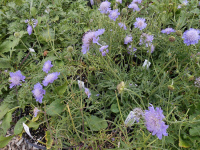Archives
Showing 153–160 of 199 results
-
Salvia sclarea Clary sage Reseeding Biennial Z 5-9
Extraordinary pastel panicles of cream, blue or pink, bi-toned bracts whorl around the stem spring – summer
ARCHIVED
Note: This is a plant not currently for sale. This is an archive page preserved for informational use.
Extraordinary pastel panicles of cream, blue or pink, bi-toned bracts whorl around the stem spring – summer
Can not ship to: Washington
Size: 3’ x 12”
Care: full sun in moist well-drained soil.
Native: Europe to Central Asia
Wildlife Value: attracts hummingbirds and butterflies. Deer resistant.Salvia is from the Latin salveo meaning “to heal” referring to the plant’s ancient medicinal uses. This species introduced to gardens from the south of Europe in 1562.
-
Sanguisorba tenuifolia Great burnet, Japanese burnet Z 4-8
One to two inch long spikes - purplish red, in late summer
ARCHIVED
Note: This is a plant not currently for sale. This is an archive page preserved for informational use.
One to two inch long spikes – purplish red, in late summer
Size: 4-6’ x 12”
Care: sun to part shade in moist well-drained soil
Native: Northern AsiaSanguisorba is Latin meaning to soak up blood, for the plant’s reputed ability to clot blood.
Collected by 1851.
-
Scabiosa columbaria f. nana Dwarf dove pincushions Z 4-8
Lavender- blue pincushions
ARCHIVED
Note: This is a plant not currently for sale. This is an archive page preserved for informational use.
Lavender- blue pincushions on this short, front-of-the-border flower that blooms for four, yes, 4, months, June to September. Deadhead to promote reblooming.
Size: 6-12” x 12-18”
Care: sun to part shade in moist well-drained alkaline soil
Native: Europe
Wildlife Value: Attracts bees, butterflies and birdsDifferent colored ones including lavender and pink described in The Garden 1872.
-
Scabiosa japonica var. alpina Alpine pincushion flower Z 4-9
Lavender-blue pincushions over mound of gray-green foliage, blooms June-September
ARCHIVED
Note: This is a plant not currently for sale. This is an archive page preserved for informational use.
Lavender-blue pincushions over mound of gray-green foliage, blooms June-September
Size: 6-12” x 12”
Care: sun to part shade in well-drained soil
Native: Japan’s subalpine meadows
Wildlife Value: attracts bees, butterflies and birdsDescribed by Japanese botanist Hosayoshi Takeda before 1962.
-
Schizophragma hydrangeoides ‘Rosea’ Pink Japanese hydrangea vine Z 5-8
Deciduous woody climber clinging by adhesive, aerial roots, with showy flower-heads resembling lacecap hydrangeas, with creamy-white flowers surrounded by showy bracts that age to rosy pink, blooming in July & August & its sepals remain conspicuous long after. Heart-shaped foliage turns yellow in fall.
ARCHIVED
Note: This is a plant not currently for sale. This is an archive page preserved for informational use.
Deciduous woody climber clinging by adhesive, aerial roots, with showy flower-heads resembling lacecap hydrangeas, with creamy-white flowers surrounded by showy bracts that age to rosy pink, blooming in July & August & its sepals remain conspicuous long after. Heart-shaped foliage turns yellow in fall.
Size: 20-30’ x 6-9’
Care: part shade to shade in moist to moist well-drained soil
Native: Japan where they “climb the trunks of tall trees and blossom among the lower limbs.” Arnold Arboretum Bulletin 1933.
Wildlife Value: Deer resistant.
Awards: Royal Horticultural Society Award of Garden Merit.‘Rosea’ found by English planthunter Charles Maries c. 1878, collecting for London’s Veitch Nursery and referred to in The Book of Climbing Plants and Wall Shrubs, Samuel Arnett 1902.
-
Scutellaria alpina Alpine skullcap Z 5-9
Mounds of two-toned snapdragon-like flowers July - October.
ARCHIVED
Note: This is a plant not currently for sale. This is an archive page preserved for informational use.
Bailey (1913): “A hardy spreading perennial about 10 in. high, with ovate, serrately dentate leaves and large, purple and white, somewhat yellowish flowers in dense, terminal racemes. … A handsome rock or low border perennial.” Mounds of two-toned snapdragon-like flowers July – October.
Size: 6-10” x 12”
Care: Sun in well-drained to moist well-drained soil
Native: Pyrenees, Appennines to the Balkans; central Russia to southern SiberiaLinnaeus’ imaginative mind named this genus after the Latin sculellum meaning “a little dish,” because of its resemblance to the flower’s helmet-shaped calyx. In gardens before 1753.
-
Sedum album White stonecrop Z 3-8
Clusters of tiny white flowers bloom in mid-summer above succulent, cylindrical foliage.
ARCHIVED
Note: This is a plant not currently for sale. This is an archive page preserved for informational use.
Clusters of tiny white flowers bloom in mid-summer above succulent, cylindrical foliage.
Size: 3-6" x 12-18" spreading making an easy groundcover
Care: sun in moist well-drained to well-drained soil
Native: Europe, Western Asia and Northern Africa
Wildlife Value: Butterflies attracted to flowers, Deer and rabbit resistant.Sedum means “plant that sits.” “Live forever” is an ancient Greek name for sedums. The Roman Pliny claimed that sedum’s juice treated wounds. In the 1500’s English herbalist Gerard called sedums “very full of life,” referring to succulent’s quality of being very easy to grow. This species collected before 1671. It “grows naturally upon old walls in many parts of England.” Gardeners Dictionary, 1768. In 1867 described as “growing, ever so luxuriantly upon roofs and walls (as well as) the rocks at Great Malvern…” Botany of Worcestershire. Landscape designer Andrew Jackson Downing recommended this for edging, 1868.
-
Sedum hispanicum var. minus ‘Purple Form’ Little Blue Spanish stonecrop, Tiny buttons Z 4-9
Many petite faintly pink flowers in June, soft, succulent, glaucous leaves form a perfect mound.
ARCHIVED
Note: This is a plant not currently for sale. This is an archive page preserved for informational use.
Many petite faintly pink flowers in June, soft, succulent, glaucous leaves form a perfect mound. Perfect for rock gardens, front of border, fairy gardens, roof garden, troughs and groundcover, or any place with drought.
Size: 2” x 8”
Care: sun to part sun in well-drained soil
Native: Southern Europe, Balkan peninsulaThe variety minus is considered a synonym of the species which was described by the father of botany, Linnaeus, in 1750’s.







